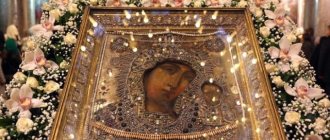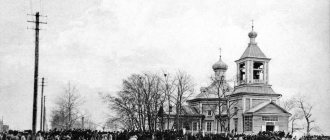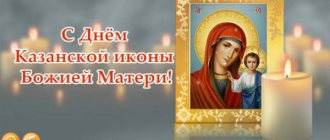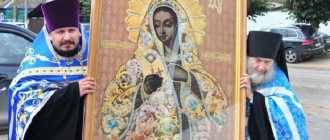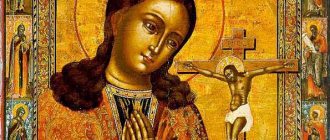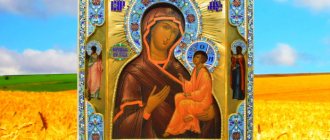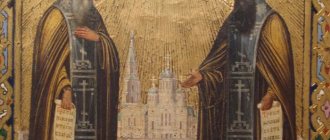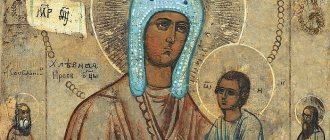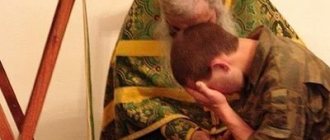"Save me, God!".
Thank you for visiting our website, before you start studying the information, please subscribe to our Orthodox community on Instagram, Lord, Save and Preserve † - https://www.instagram.com/spasi.gospodi/. The community has more than 60,000 subscribers. There are many of us like-minded people and we are growing quickly, we post prayers, sayings of saints, prayer requests, and timely post useful information about holidays and Orthodox events... Subscribe. Guardian Angel to you!
The Icon of the Mother of God of Kazan is truly miraculous. In ancient times, not only ordinary people, but also princes and kings turned to Her for help.
The patroness was of great importance for the people; according to legend, the miracles of the “Kazan” Icon of the Mother of God healed many people from various ailments, and some were even given lost sight, but She could also help in the fight against enemies and in liberating the state from enemies.
The Intercessor does truly extraordinary things, so people who are in trouble, facing difficulties at work or in their personal lives can ask Her for help in prayer before Her Divine Image. The image of the miracle worker can be hung in your home, as many people do, and can also be given as a gift.
What they pray for to the icon of the “Kazan” Mother of God, its meaning, how it can protect and help, and much more you can learn from this article.
History of the miraculous list
In Kazan, after a fire in 1579, a holy face miraculously appeared. It was discovered by the little girl Matrona, the daughter of a merchant, who in a dream saw the Mother of God, who ordered her and her mother to go to the fire and get the icon from under the rubble. Subsequently, the found image of the Saint, to the surprise of people, was very bright and beautiful, and the colors were fresh.
At the same place where the valuable find was discovered, a monastery for women was erected, and the Divine painting itself was transported to the Assumption Cathedral (Kazan). However, because of its jewelry, the miraculous face was stolen in 1904 and then destroyed. Today, only copies of the Holy Image have survived.
The fate of the image of the Kazan Mother of God
The icon, revealed in 1579, remained in Kazan, in a monastery built on the site of its appearance. It was decorated with rich vestments - frames made of gold and precious stones. On the night of June 29, 1904, the icon was stolen by attackers. The police managed to detain the criminal; he turned out to be a certain Fyodor Chaikin , also known as Bartholomew Stoyan . At the trial, he admitted that he stole the icon because of its rich setting, and burned the image itself in the oven. Indeed, pieces of burnt fabric and jewelry that decorated the image were found. But later Chaikin himself, while in prison, said that he gave the icon to a person whose name he could not reveal even under the threat of death. Thus was born the legend that the icon is kept by the Old Believers . One of the versions, where the original image of the Kazan Mother of God is actually located, can be read in the article “The Secret of the Revealed Image.”
At the beginning of the 20th century, the Ministry of Internal Affairs conducted several investigations related to the “Old Believer trace” in the case of the Kazan Icon. Several times it seemed that the image was about to be discovered. There were witnesses who allegedly saw the icon in a secret underground prayer room and even participated in its movement. Thus, a certain prisoner Torshilov told investigators: “... the icon of the Kazan Mother of God is intact and is kept by the Old Believers in the prayer room, but it is very, very strictly guarded, so it is very difficult to take the icon from the prayer room.” But a thorough check of such testimony indicated the inconsistency of the information.
These rumors, however, have survived to this day. Relatively recently, journalists asked questions about the fate of the Kazan Icon to Metropolitans of the Russian Orthodox Church Alimpiy (Gusev) and Andrian (Chetvergov). Perhaps this is just a legend, but the Old Believers really revered and still reverence Kazanskaya. Almost every home has this image. And the procession with the miraculous Guslitsky icon continued even in the 60-70s.
When is the celebration in honor of the holy face?
This divine holiday is usually celebrated twice a year:
- July 21, new style (July 8, old style). After the little girl Matrona had visions in her sleep, this event was defined as an important Orthodox holiday, “The Appearance of the Image of the Mother of God,” celebrated annually since the 16th century;
- November 4 (October 22). In the autumn of 1612, Moscow was liberated by the Russian army led by Prince Dmitry Pozharsky and Kuzma Minin from the Polish-Lithuanian occupiers.
The best article for you, go to: The icon “The Savior Not Made by Hands” helps
Before the decisive battle, the Russian regiments prayed to the divine image, thanks to which the victory was won. In honor of the Saint’s intercession, a holiday was established, celebrated since 1649 throughout Rus'.
After the October Revolution, November 4 ceased to be a non-working day, but the tradition was restored in 2005, and the holiday was called “National Unity Day.”
Every year on November 4 and July 21, the same service is held where a sermon is read and the following kontakion sounds:
“Let us come, people, to this quiet and good refuge, to the ambulance, ready and warm salvation, to the protection of the Virgin. Let us hasten to prayer and strive for repentance: for the Most Pure Theotokos exudes boundless mercies to us, advances to our aid and delivers Her well-behaved and God-fearing servants from all troubles and evils.”
Russian Orthodox Church
The celebration of the Mother of God on July 8 (today this day corresponds to July 21 according to the civil calendar) in honor of Her Kazan Icon begins with its miraculous appearance in Kazan in 1579. Some time after the conquest of Kazan by the young Tsar Ivan Vasilyevich the Terrible, his establishment of the Kazan diocese and After the successful spread of Christianity, the Mohammedans began to show strong resistance. The fire of 1579, which destroyed half of the Kazan Kremlin and the adjacent part of the city, they regarded as the wrath of the “Russian God.” It was at this time that to strengthen Orthodoxy in Kazan, the mercy of God was revealed through the miraculous discovery of the icon of the Mother of God, which on this occasion received the name Kazan.
Appearance of the miraculous icon
Matrona, the nine-year-old daughter of the archer Onuchin, who intended to build a new house for himself on the site of the fire, the Mother of God appeared in a dream, commanding her to inform the archbishop and mayors that they should remove Her image from the ground, indicating the place in the ashes where it was necessary to dig.
Since no one paid attention to the child’s words, the Mother of God appeared a second time, and the third time the girl in a dream saw the icon itself, from which came a menacing voice: “If you do not tell My words, I will appear in another place, and you will perish.” Then the mother of the frightened girl took her daughter to the governors and Archbishop Jeremiah, but no one believed the child’s words.
Finally, on July 8, the mother and her assistants began to dig as directed by her daughter, but only when the girl herself took up the spade and began to dig near the stove did an icon of the Mother of God appear, wrapped in an old cloth sleeve. The face of the icon was clear, as if it had just been painted, and had not been damaged at all by the fire (the iconography of the Kazan image is a type of Hodegetria the Guide). Having learned about the miracle, the archbishop and the mayors, in a solemn religious procession, came to the place of the miraculous discovery of the icon and transferred it to the Church of St. Nicholas of Tula, then, after a prayer service, to the Annunciation Cathedral.
The events of the appearance and transfer of the image were described by the priest of the St. Nicholas Church, Ermolai, the future Metropolitan of Kazan and then the Patriarch of Moscow Ermogen, who suffered as a martyr for Orthodoxy in troubled times. He also owns the service in honor of the Kazan Icon, including the well-known troparion: “The zealous Intercessor...”. He also witnessed the first miracles that happened during the celebration: on the way, Joseph, who had been blind for three years, received his sight; in the cathedral itself, another blind man, Nikita, was healed. Subsequently, the special mercy of the Mother of God through Her Kazan image to suffering eyes was also noticed.
After the archbishop and the governors sent the tsar a detailed description of the discovery of the icon with an exact list of it, he ordered a convent to be built on the site of the apparition. The first tonsures of the monastery were the youth Matrona and her mother. In 1595, Metropolitan. Hermogenes rebuilt the new Assumption Cathedral and increased the staff of nuns to 64 people; The miraculous image was surrounded by royal gifts - gold, precious stones and pearls. In 1798, new decorations were placed by Empress Catherine, and she also allocated 25 thousand rubles. for the construction of a new cathedral monastery church, consecrated in 1808.
Revered lists of the Kazan Icon
The Russian Church especially revered two miraculous copies from the Kazan image of the Mother of God, which twice accompanied the Russian army in the fight against foreigners: Moscow and St. Petersburg. The first list, after the secret appeal of Patriarch Hermogenes, taken by the Kazan squad on a campaign in 1611, was transferred to the squads of the northern cities under the leadership of Prince Dm. Pozharsky, who went to liberate the capital from the Poles.
After the fervent prayer of the Russian soldiers to the Mother of God in front of Her image, it became known about the vision of St. Sergius of Radonezh to the Greek Archbishop Arseny of Elasson, imprisoned by the Poles in the Kremlin, who announced to him that through the intercession of the Queen of Heaven, the reigning city was freed from enemies.
Having received such spiritual support from the Mother of God, on October 22 (today this day corresponds to November 4 according to the civil calendar), the Russians drove the Poles out of Kitay-Gorod, and then the invaders themselves surrendered the Kremlin. The clergy came out to meet the Russian army with Moscow shrines, and ahead of the liberators walked the Mounted Voivode Herself in Her Kazan image.
Until the new revolutionary unrest, this icon remained in the book built for it. Pozharsky Kazan Cathedral on Red Square. Since 1649, by order of Tsar Alexei Mikhailovich, local celebrations - Kazan on July 8 and Moscow on October 22 - became all-Russian, and the Kazan Icon began to be revered as the patroness of the House of Romanov.
The second revered list, which belonged to the Dowager Empress Praskovia Feodorovna, was transferred, among other shrines, by Emperor Peter the Great to the northern capital he was establishing, where it became one of the most important shrines of the city of St. Petra. In 1811, the Kazan Cathedral was built in honor of this image.
The next year, 1812, M.I. Kutuzov, appointed commander-in-chief of the Russian army by Emperor Alexander I, before leaving for the active troops, prayed in front of the St. Petersburg shrine and, by placing a holy icon on him, received the blessing of the Mother of God for the holy cause of fighting the invaders.
From silver looted by the French and taken by the Cossacks, Kutuzov built a silver iconostasis in the cathedral - a gift from the Mother of God. The ashes of the glorious commander, known for his piety, rested under the arches of the Kazan Cathedral next to the miraculous image of the Mother of God, who did not reject his prayers and, under his leadership, granted victory to the Russian army over the armies of Napoleon.
During the Great Patriotic War, when their strength was already running out, the residents of the blockaded city on the Neva made a religious procession with the Kazan Icon of the Mother of God, which undoubtedly added resilience to the believing townspeople and helped them survive to the end. Miraculously preserved during the revolutionary hard times, the St. Petersburg copy of the Kazan Icon is now kept in the Prince Vladimir Cathedral, awaiting its return to its place in the iconostasis of the Kazan Cathedral after its restoration.
The story of the revealed miraculous image sadly ended at a difficult time for Russia at the beginning of the 20th century. On the night of June 29, 1904, the cathedral of the Kazan Monastery was robbed by sacrilege; The miraculous icon of the Mother of God also disappeared without a trace. During the investigation, the thieves showed that they sold the precious robe, and chopped up and burned the icon. That same year, the Russian army suffered setbacks in the Far East.
In addition to these three icons, many other copies of the Kazan Icon of the Mother of God in different parts of our vast Motherland became famous for the miracles of healing and mercy of the Queen of Heaven to the Orthodox people, for which the Russian people loved this image very much. In a rare church you will not find the Kazan Icon; It is also most often used to bless young people for family life.
Return of the Honored List from the Vatican
After the revolution of 1917, the atheistic regime mercilessly dealt with the spiritual heritage of the Russian people and consistently destroyed shrines that were precious to the believer’s heart. Many icons, for the sake of their antiquity and rich frames, were auctioned off and fell into the hands of Western collectors.
One of the copies of the Kazan Icon of the Mother of God, written in the 18th century. and decorated with a precious frame and stones, was sold abroad, and then bought and presented to Pope John Paul II, in whose chambers the icon had been located since 1993. According to some assumptions, this icon belonged to the founder of the Diveyevo community, Schema nun Alexandra (Melgunova) and in her for a time it was kept in the Kazan Church in the village of Diveeva.
The desire to transfer this icon to the Russian Orthodox Church was expressed by the pope for a very long time. In 1997, the condition for the transfer was a personal meeting of the head of the Vatican with His Holiness Patriarch Alexy II, which was unacceptable for the Russian Church due to the complicated relations with Rome in recent years. In 2000, civil authorities became interested in the issue of returning the image, and the option of transferring the icon by the pope to the Patriarch in Kazan during the pontiff’s flight to Mongolia began to be considered.
In 2003, a mixed commission carried out an art history examination, which determined that the icon is not one of the three main images, but is a copy of the 18th century, made under the frame (that is, only the faces and hands are well depicted) and, judging by the frame belonged to a wealthy family.
After the examination, the Catholic administration again announced the possibility of John Paul II coming to Russia to hand over the icon, to which there was a negative reaction from the Synodal Department for External Church Relations. It indicated that the transfer of the icon was not a sufficient basis for the pope’s visit, and the visit itself by that time did not even appear as a subject of inter-church negotiations (Church Bulletin, No. 9-10 (262-263) May 2003).
Next year, 2004, the Catholic Church decides to transfer the list of the Kazan Icon without any conditions. On August 25, a solemn farewell to the icon took place in Rome, and on the feast of the Dormition of the Blessed Virgin Mary on August 15/28, 2004, during the Divine Liturgy in the Assumption Cathedral of the Moscow Kremlin, the venerable list was handed over by a delegation of the Roman Catholic Church led by Cardinal Walter Kasper, Chairman of the Pontifical Council to promote Christian unity, the Russian Orthodox Church in the person of its High Hierarch, His Holiness Patriarch of Moscow and All Rus' Alexy II.
The return of the Kazan image of the Mother of God to the Motherland is perceived, on the one hand, as the great mercy of God to the Russian people, and, on the other, as evidence of the good intentions of the Vatican to return to sincere relations with the Russian Orthodox Church, free from the unkind rivalry with which they have been overshadowed in recent times. decade. Until a decision is made on the permanent location of this image, it is kept in the home church of the working residence of His Holiness the Patriarch in Moscow.
Deacon Mikhail Asmus
Where is the icon of the Kazan Mother of God located?
The miraculous lists have the earliest dating date - 1606 and are located in the Tretyakov Gallery (Moscow).
At the residence of the Moscow Patriarch in the capital's house church there is another copy of the image of no less importance, which was received as a sign of the end of the rivalry as a gift from the Roman Catholic Church to the Orthodox Church of Russia.
The copy of the Holy Face of the Mother of God is considered to be the closest to the ancient prototype of that time, and it is stored in St. Petersburg in the Prince Vladimir Cathedral.
Voice of the people
The Kazan Icon of the Mother of God is one of those whose glorification came “from below,” not from church authorities and hierarchs, but from the people.
This story is well known: in 1579 in Kazan, where Christianity had just appeared, the Mother of God appeared to nine-year-old Matrona in a dream and ordered her to “inform the archbishop and mayors so that they remove Her image from the ground,” indicating the place where to look.
Matrona told her mother everything, but she did not pay attention either the first or the second time. The third time, the icon itself was revealed to the girl in a dream, and the Mother of God repeated her order, warning that if Her words were not believed, the city would be in danger.
The frightened girl begged her mother to go to the priests. The mother took the child to Archbishop Jeremiah, but he did not believe the strange words of the nine-year-old child. Well, who would believe it?
But the girl did not want to calm down. Finally, the mother herself began to dig up the place where, according to Matrona, the icon was located. But only when a child took up the excavations did an icon appear, wrapped in cloth. The icon was completely “new”, as if it had not come from underground.
Rumors of the miracle quickly reached the archbishop's chambers. Amazed, Archbishop Jeremiah and the mayors hurried to Matrona’s house and in a solemn religious procession, with prayers, transferred the miraculously found image to the Annunciation Cathedral in the city of Kazan.
This wonderful event has its own documentarian, the glorified patriarch Hermogenes, who inspired the people to fight for faith and country in the Time of Troubles and was tortured to death by starvation in a prison basement.
At the time of the events described, he served as a simple priest in the St. Nicholas Church of Kazan and was called Father Ermolai.
“Reveal to yourself the icon of the Mother of God in the gray image,” wrote Fr. Ermolai. - Do not show the image of your Lady either to the saint of the city, or to the ruler of the ruler, lower than a noble or rich, lower than a wise old man: but show your honest treasure, an inexhaustible source to those who come with faith, your wonderful image, a certain man from the simple, who has wisdom in shooting war , this young woman, ten years old, named Matrona.
This wonderful maiden appeared and the blessed icon of the Theotokos. And after the fire in the same year and month, this maiden began to appear to her, her name was before the river, the icon of the Blessed Mother of God. And he wounded her in hail and cheerful about the icon of the Virgin Mary, the same Vid, the archbishop and governors, so that they would have the image of the Most Holy Theotokos from the Earthly: And the very one, I, more, follow the shallow of the Dragago Biser, an honest treasure, the icon of the Bogoroditsyn. ”
It was Patriarch Hermogenes who wrote the service in honor of the Kazan Icon and the famous troparion: “The zealous Intercessor...”.
At the site where the image was found, according to the royal decree (and with many gifts), a convent was built, the first nuns of which were Matrona and her mother.
What could be the meaning of what is reflected in the notes of Svshchmk. Patriarch Hermogenes some kind of opposition between power, might, wisdom - and the simplicity of a child?
You can remember the words of Christ about the child, whom He cited as an example, when the disciples began to argue about who was greater in the Kingdom of Heaven (Matthew 18: 1-6) “Jesus called the child, set him in the midst of them and said: Verily, I say to you , unless you are converted and become like children, you will not enter the Kingdom of Heaven; So whoever humbles himself like this child is the greatest in the kingdom of heaven. If you do not humble yourself as children, you will not enter the Kingdom of God.”
“Children are an image of those born again into the Kingdom of God, born of the Spirit,” says one of the interpreters. “Truly, truly, I say to you, unless someone is born again, he cannot see the Kingdom of God,” Christ says to Nicodemus. (John 3:3).
The child is such an image of one reborn for the Kingdom of God, one who is no longer interested in the question: who is greater, me or my friend; who no longer evaluates himself or others according to the characteristics of this world: power, wealth, honor.
A child is one who has become “small” enough to joyfully need the Father, trusting Him in everything, following Him wherever He leads.
According to Jerome of Stridon, the child here is Christ Himself: “He placed Himself among them as a child, because He came to serve, and not to be served, so He set them an example of humility.”
“Such a child is the one who treats meek and humble people with love, like children, in the name of Christ, that is, in fulfillment of the commandment to love all the weak and humiliated, he will do this as to Christ himself,”
- adds Archbishop Averky Taushev.
Often, speaking about miraculous icons, people ask: what does it “help with?” When the Kazan image was transferred to the church, at the very first time two blind people received their sight (Patriarch Hermogenes also writes about this). Thus, it was noticed that the Mother of God of Kazan helps the “eyes.”
But a person consists of body and soul. And not only physical vision is strengthened by the Mother of God of Kazan, but also our spiritual vision - the ability to see things in the light of Christ, that is, in the True Light that enlightens the world - as a child sees, to see first of all the good in oneself, in others, in life .
What does the meaning of the Kazan icon help with?
The face of the Mother of God is an image of Hodegetria the Guide, who has helped people find their true path countless times.
During the Time of Troubles, entire troops went to Moscow under Her protection, soon bringing the liberation of the city from Polish impostors and invaders.
Before the start of the well-known Battle of Poltava, Peter I said some of his most powerful prayers in front of this image of the defender. And in 1812, the same Holy Face helped Russian soldiers repel the raid of French enemies, thereby gaining the beginning of the victories of Russian troops against Napoleon in the Patriotic War. Prince Mikhail Kutuzov also stood before Her in prayer before heading to the active army.
But not only troops and rulers of states can receive the blessing and salvation of the image; ordinary people also turn to the “Kazan” Mother of God for help, and the list of miracles that She bestows on people is constantly growing.
Description of the icon
In terms of iconographic type, the Kazan Icon belongs to Hodegetria (Guide), however, in an abbreviated version - the image is not half-length, but shoulder-length, in clothes characteristic of the Mother of God icons. The head of the Virgin Mary is slightly inclined towards the Infant Jesus, who has raised his hand with his fingers folded in a blessing gesture. The expression on the face of the Mother of God is mournful in anticipation of the torments awaiting Her Son, and the face of the Child is striking in its maturity and seriousness. Their gazes are turned directly to the person praying, which gives the feeling that They are looking directly into the soul.
What do they pray for to the icon of the Kazan Mother of God:
- When healing any bodily ailments, they especially ask for help in healing from loss of vision, but also in spiritual insight, to find the right path when the fire of faith weakens in the soul;
- In prayers they ask for a protector and for support in difficult life situations, when there is not enough strength to fight adversity. With any sorrow and sorrow, the Mother of God will help with her instructions and consolation;
- The guidebook will help you make the right decision, protect you from making mistakes and misfortunes, and will also show you the path to a good goal. Many stories describe the appearance of the Holy Face in the dreams of those in need, where the Mother of God said how to avoid or correct the consequences of trouble, what needs to be done and what is best not to do;
- They also pray to the Saint for help to soldiers defending their native land and from getting rid of enemy attacks;
- Not only in times of adversity, but also in joys, they turn to the Kazan Mother of God, blessing the young for marriage.
- There are many signs associated with this icon. For example, if a wedding falls on the celebration of the Holy Image, then family life will be happy, and the spouses will live in harmony;
- For those married couples who ask the icon of the Kazan Mother of God to improve their relationship, it helps to avoid troubles and strife, as well as to bring harmony and well-being;
- The Kazan Mother of God especially shows her favor towards children, protecting them from misfortunes, sorrows and helping them on the path of life.
The best article for you, go to: Venerable Hilarion of Gdov, Pskovoezersky
This is where the Kazan Icon of the Mother of God helps, everyone who needs it, everyone who believes, asks for protection and blessings, everyone without exception.
Folk traditions of the holiday of the Kazan Icon of the Virgin Mary
The Feast of the Kazan Icon of the Mother of God has always been an important date in the folk calendar.
This day was considered the boundary between autumn and winter. People said: “Go to Kazanskaya on wheels, and put the runners in the cart,” “Mother Kazanskaya leads a snow-free winter, shows the way to the frosts,” “It’s not winter before Kazanskaya, but it’s not autumn from Kazanskaya.” During this period, the peasants were finishing their seasonal construction work. In the old days, the Autumn Kazanskaya was always the time for settlements, the agreement “To Kazanskaya - settlement!” no one dared to disturb, they were also afraid of the coming cold weather.
The holiday of the icon of the Kazan Mother of God is considered one of the most important women's holidays. The Kazan icon has long been considered a female intercessor. Belated weddings were also timed to coincide with this holiday, as there was an ancient belief: “Whoever marries Kazanskaya will be happy.”
How to pray in front of the Holy Image
In order for the Mother of God to hear your request, you must pray to her correctly. This can be done both in the temple and at home. If at home you want to ask a holy image for help, it is best to pray in the morning:
- After you wake up, wash yourself well with water, cross your hands in advance and set yourself up for positive emotions;
- Calm down and get all annoying and negative thoughts out of your head;
- Light the candles, kneel down and then begin the ceremony;
- The quantity is not the most important thing, but what is important is that all the words of the prayer are spoken sincerely, from a pure heart;
- After you have prayed, you can express your request to the Mother of God. But remember that a request will not be heard if it contains at least one negative wish.
Prayers to the “Kazan” Icon of the Mother of God
Oh, Most Holy Lady and Lady Theotokos! With fear, faith and love, falling before Your honorable icon, we pray to You: do not turn Your face away from those who come running to You. Pray, merciful Mother, to Thy Son and our God, the Lord Jesus Christ, to preserve our country peacefully and to keep His holy Church unshakable from unbelief, heresies and schism. There are no imams of any other help, no imams of other hope, unless You, Most Pure Virgin, are You the all-powerful Helper and Intercessor of Christians. Deliver all who pray to You with faith from the falls of sin, from the slander of evil people, from all temptations, sorrows, troubles and from vain death. Grant us the spirit of contrition, humility of heart, purity of thoughts, correction of sinful lives and the remission of sins, so that we all sing gratefully of Your greatness, we will be worthy of the Heavenly Kingdom, and there with all the saints we will glorify the Most Honorable and Magnificent Name of the Father and the Son and the Holy Spirit. Amen.
Second prayer:
Oh, Most Holy Lady Theotokos, Queen of Heaven and earth, the highest angel and archangel and all creatures, the most honest, pure Virgin Mary, good Helper to the world, and affirmation for all people, and deliverance in all their needs! Look now, O All-Merciful Lady, upon Thy servants, Praying to You with a tender soul and a contrite heart, falling with tears to You and worshiping Your most pure and wholesome image, and asking for Your help and intercession. Oh, All-Merciful and Most Merciful Virgin Pure Mother of God! Look, O Lady, at Thy people: for we are sinners and imams of no other help than to You and from You, Christ our God born. You are our intercessor and representative. You are protection for the offended, joy for the sorrowing, refuge for the orphans, guardian for widows, glory for virgins, joy for those who weep, visitation for the sick, healing for the weak, salvation for sinners. For this reason, O Mother of God, we resort to You, and hold Your Most Pure Image with the Eternal One in Your hand As an infant, our Lord Jesus Christ, looking at You, we offer tender singing and cry: have mercy on us, Mother of God, and fulfill our request, for all things are possible through Your intercession, for glory is due to You now and ever and unto the ages of ages. Amen.
God bless you!
The best article for you, go to: Icon of Demetrius of Prilutsky
"Hodegetria" means "guidebook"
The mystery remained a mystery again.
The smile of the Mother of God on the mysterious postcard took on a special meaning each time. Sometimes it seemed that the Mother of God was not smiling at all, and sometimes she was simply beaming with happiness. The Mother of God is alive here. How not to remember the descriptions of the Images created by the Evangelist Luke. They were considered a source of grace even in early Christianity. Such a divinely inspired image, influencing the person praying in front of it, gave a feeling of experiencing a personal meeting, blurring the boundaries between image and image.
In one of the descriptions of the Kazan icon you can read: “How touching and spiritual is Her face! The Mother of God is depicted with her head bowed to Her Son. The Divine Infant is presented with a blessing right hand, and the face of the Mother of God radiates such love that it is difficult to imagine anything higher than this image, surpassing all human art. Her bright eyes reflect thoughtfulness, but not vain thoughtfulness, not anxious, but quiet maternal thoughtfulness and endless mercy. The eyes of the God-Child, living human eyes, look above the earthly, in their childish expression one can see the mind of an adult, and in childish tenderness - Divine power, His whole face is filled with Divine beauty.”
What distinguishes the image on the postcard from the Vatican list? On it, as on many Kazan icons, the Mother of God looks straight. And on the “grandmother’s” postcard, the Mother of God, like a real Hodegetria - a guide, points to the baby! But not by hand, as we see on the Smolensk, Tikhvin and other waist icons. With a special turn of her head and glance, she lets us know to whom we need to direct our prayers, to whom we should ask for salvation.
Art critics noticed the same detail. Speaking in 2002 at the conference “Christianity in the Volga-Ural Region: History and Culture,” N. Chugreeva, senior researcher at the Andrei Rublev Museum of Ancient Russian Culture, drew the audience’s attention to a number of facts proving that we are dealing with different icons. This can be seen, for example, in size: the Vatican icon is much larger than the Kazan icon - 31.12 x 26.49. The size of the Kazan image is 26.7x22.3 cm. As is known, the lists are always larger in size than the original icons, emphasized N. Chugreeva. She claims that in the Vatican there is a list made much later than the original - in the first half of the 18th century. This is proven by numerous testimonies of specialists who studied the Vatican icon from photographs.
The expert on icon painting elaborated on the differences, emphasizing that over time, a stable and simple iconography of the Kazan Icon developed: the Mother of God is depicted without arms, leaning towards the baby, the baby is upright, he is standing, not sitting. The Vatican icon differs from earlier copies in that the Mother of God is addressed to those praying, while on the earlier copies She looks at Christ. The gaze directed at the worshipers is a sign of later icons. On the Vatican list, the blessing gesture is nominal (the fingers depict two letters of the name - “Jesus Christ”), while on the early images it is two-fingered.
But where is the amazing icon with the “correct turn of the head” kept today? I set out to find her, to see her. On the day when the Church honors the Kazan Icon, I called the Kazan Diocesan Administration of the Russian Orthodox Church in order to find out where the Bishop was serving the Liturgy. I was told that it was in the Yaroslavl Wonderworkers Church at the Arskoye Cemetery. The official website of the Kazan Diocesan Administration states that it contains a mid-18th century list of the miraculous Kazan Icon of the Mother of God, located in the front part of the right choir.
The search led to a small cemetery church.
The church in the name of the holy noble princes Theodore and his children David and Constantine is the only one that did not close during the Soviet years. One of the most prayed and revered places in Kazan. By the end of the 30s, all the monasteries and most of the city churches were closed, so all the shrines were moved here. Among them are a shrine with the relics of the saint and wonderworker Gury, the first Archbishop of Kazan, an ancient icon of Sergius of Radonezh, and “the same” icon of the Mother of God.
When I saw her, I was surprised. The face was so dark that it seemed that there was nothing at all behind the glass... (Later I found out that, like the revealed one, this icon was hidden under a layer of mica). I began to pray to the Mother of God that She would show Her Face to us, that She would “return” to us. Coming out of the church, I saw a lot of postcards in the church shop. The same ones that the mysterious old woman wanted to give to the Lord. And on all of them there is a Photoshopped, “highlighted” Image of the Queen of Heaven. I recognized Him immediately! So, does this mean that the real revealed icon is kept in this temple?
If you read the legend about the discovery of the icon, you can find many coincidences. Both icons are hidden under mica and have similar features. It is known that the icon was small in size - this is indirectly confirmed by the fact that it was wrapped in a single-row sleeve. The size of the icon (6 × 5 vershoks, or 26.7 × 22.3 cm) is given by the Kazan church historian Professor of the KDA G. Z. Eliseev (Eliseev. 1858. P. 391); the same size is indicated in the inventory of the Kazan nunnery of 1853 (RGIA. F. 834. Inventory 3. No. 2631. L. 5-9). The icon was “Greek writing, dark in color,” the image of the Mother of God is bust-length, hands are not visible, the head is bowed to the Infant Christ, depicted upright, standing. His right hand is laid aside in a gesture of two-fingered blessing, his left hand is lowered and hidden under the himation. Decorative motifs of the frame of the 19th century. close to the festive robe revealed by Kazan. On the inner frame there were 11 stamps with images of holidays (“Conception of the Blessed Virgin Mary” (“Meeting of Joachim and Anna”), “Nativity of the Blessed Virgin Mary”, “Introduction of the Blessed Virgin Mary into the Temple”, “Annunciation”, “Nativity of Christ”, “Cathedral of the Blessed Virgin Mary” Theotokos", "The Presentation of the Lord", "The Dormition of the Blessed Virgin Mary", "Rejoices in You", "Praise of the Blessed Virgin Mary", "Protection of the Blessed Virgin Mary"), in the last, 12th hallmark the discovery of the icon was presented, saints are depicted on the margins of the frame .
But the most important thing is an amazing look!!! The Mother of God does not look directly, but at the Divine Child .
The first to attribute Kazanskaya to the “Hodegetria” type was Patriarch Hermogenes. It is in his “Tale of the appearance of the miraculous icon of the Most Holy Theotokos in the city of Kazan” that it is first called “The Image of Our Most Pure Lady Theotokos and Ever-Virgin Mary the Honest and Her Glorious Hodegetria.” Later researchers were perplexed why the icon was called Hodegetria. Perhaps the researchers did not see this face, so clearly “showing the Path with its gaze.”
Expert in church antiquities, professor of the Kazan Theological Academy I.M. Pokrovsky notes about this:
It is completely incomprehensible why they could call the Hodegetria of Kazan, when all the literati of that time, including chroniclers, knew well that the Smolensk icon, transferred to Rus' back in 1046, is called Hodegetria. True, the Kazan revealed icon in the “Tale” of Hermogenes, and hence in the prologue, is called Hodegetria, but not a copy of Hodegetria. In explaining this name of the Kazan Icon, we dare to assume that the compiler of the legend, written fifteen years after the appearance of the icon, named the Kazan Icon of Our Most Pure Lady Theotokos, the honest and glorious Her Hodegetria, for personal reasons.
THEM. Pokrovsky cannot find another valid reason, only as the personal “arbitrariness” of the person who saw her. A simple well-known fact is overlooked by the “expert in church antiquities.” The first copies of the revealed icon were made taking into account the correctness of the composition, and in the Kazan Icon of the Mother of God this was a special rotation of the head of the Mother of God and a special position of the Infant God. Maybe the name was determined by the turn of the head, the glance at Christ?
Art critics often did not always justifiably “lead” believers away from the true memory of the revealed image. And today there are people who “categorically and authoritatively” rejected the version that the Kazan Icon of the Mother of God from the Church of the Yaroslavl Wonderworkers is the original.
When examining this icon during the International Scientific and Practical Conference “Christianity in the Volga-Ural Region” held in Kazan in 2002 under the auspices of the Moscow Patriarchate and the International Union of Anthropological and Ethnological Sciences at UNESCO, it was found that the icon belongs to the 2nd half XVIII century A female art critic from Moscow categorically refuted all justifications for the similarity, saying a phrase that has forever stuck in my mind: “And in general, the style of writing this icon is not canonical, not ancient. This is some kind of southern Russian handicraft style.”
But does the southern Russian style prevent an icon from being real? Just the opposite! Not many modern people know that the modern inhabitants of Kazni - whether they call themselves Bulgars or Turks, it makes no difference - came to the Volga banks precisely from the south.
The main discovery that I made at the end of this almost detective story is the following: the importance of the original compared to the list is enormous ! You can change a lot on the copy, distorting the essence of the Image to the opposite meaning: you can turn your head and “unbend” your fingers, no matter how terrible this sacrilege sounds. This is quite possible, as Nikon’s reforms showed. If we have the original, all the more miraculously revealed to us by the Providence of God, then everything in it is exactly as it really was! The Lord turns to us, wanting to reveal His Revelation through this Image. He calls on those who “having ears, hear, having eyes, see.” You can tell those “invited” everything, but they will not understand, they will not believe, they will pass by... Only the “chosen ones” can discern the “essence of the Message” in the sequence of events, especially iconography or in the facts of the phenomenon. And these Images will reveal to the soul of a sincere believer the hidden Secrets of Divine Guidance. It is incredibly difficult for a person to understand these Mysteries, and moreover, the closer you seem to be to the solution, the further you are actually from it. On the spiritual path that Hodegetria shows us, there is an infinitely long road, an incomprehensible mountain height, a terrible depth of an abyss, but man is called to follow this path - following Christ!
Prayers
Troparion, tone 4
O zealous intercessor,/ Mother of the Lord Most High,/ pray for all Thy Son Christ our God,/ and let all be saved, into Thy sovereign protection of those who flee./ Intercede for us all, O Lady ́ Queen and Lady, / like in adversity and sorrowful, and in illness, burdened with many sins, / standing and praying to You with a tender soul and a contrite heart, / before Your most pure image with tears, / and irrevocably I give them hope those who are on You, deliverance from all evils, / grant usefulness to everyone and save everything, Mother of God Virgin :// For You are the Divine protection of Your servant.
Kontakion, tone 8
(Similar to: Taken:)
Let us come, people, to this quiet and good haven,/ to the quick Helper, ready and warm salvation, the protection of the Virgin,/ let us hasten to prayer and strive for repentance:/ for it exudes sorrow to us The blessed mercy of the Most Pure Mother of God, / advances to help and delivers from great troubles and angry// His well-behaved and God-fearing servants.
Greatness
We magnify Thee,/ Most Holy Virgin,/ and honor Thy holy image,/ from which flows gracious help// to all who flow to it with faith.
